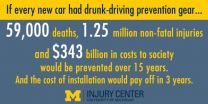(Press-News.org) ANN ARBOR, Mich. -- If every new car made in the United States had a built-in blood alcohol level tester that prevented impaired drivers from driving the vehicle, how many lives could be saved, injuries prevented, and injury-related dollars left unspent?
Researchers at the University of Michigan Injury Center and the University of Michigan Transportation Research Institute studied the impact of installing these alcohol ignition interlock devices in all newly purchased vehicles over a 15-year period; their estimates of injury prevention and cost savings are significant.
They concluded that the country could avoid 85 percent of crash deaths attributable to alcohol-involved motor vehicle crashes during the 15-year implementation period. That would mean preventing more than 59,000 deaths, the team reports in a paper published online in the American Journal of Public Health.
Another 1.25 million non-fatal injuries would also be prevented, they calculate, as the nation would see a reduction of 84-89 percent.
And when it comes to dollars, all these lives saved and injuries prevented would save U.S. society $343 billion over 15 years. In fact, the cost of installing the devices would be recouped after just three years.
"We knew our modeling would yield significant results, but the sheer numbers of preventable fatalities and serious injuries were surprising. Our analysis clearly demonstrates the significant public health benefit and societal cost savings associated with including alcohol ignition interlock devices as standard equipment in all new cars," says lead-author Patrick Carter, M.D., an assistant professor in the Department of Emergency Medicine at the U-M Medical School and core faculty at the U-Michigan Injury Center.
This is the first study in the United States that models the impact of a universal policy installing alcohol interlocks on all new vehicles sold in the U.S. It was based on two national data sets used frequently in analyses of motor vehicle crashes: the Fatality Analysis Reporting System; and the National Automotive Sampling System's General Estimates System data sets (2006-2010).
Younger drivers would benefit more
Though the injury prevention benefit was apparent for all ages, drivers who are closes to the legal drinking age would likely be the most significant beneficiaries of alcohol interlocks.
Among drivers age 21 to 29 years, 481,103 deaths and injuries would be prevented, nearly 35 percent of total deaths and injuries for all age groups. Drivers less than 21 years old who engaged in drinking while driving would also benefit substantially, with 194,886 deaths and injuries potentially prevented.
"It is often difficult to penetrate these age groups with effective public health interventions and policies to prevent drinking and driving," says Carter. "By capitalizing on recent technological advancements that make alcohol-detecting sensors seamless to the driver and applying such technology more broadly to all newly built vehicles, we can actually have a substantial injury prevention impact among traditionally hard-to-reach high-risk populations."
The estimated injury prevention impact was derived first by modeling the proportion of the alcohol-related crashes that are preventable for all vehicles less than one year old and then repeating the analysis for each year of a projected 15-year timeframe. Cost saving were determined by applying existing crash-induced injury cost metrics.
INFORMATION:
Co-authors are Rebecca M. Cunningham, M.D., a professor in the Department of Emergency Medicine and the U-M School of Public Health, and director of the U-M Injury Center, which is funded by the Centers for Disease Control and Prevention; and Jonathan D. Rupp, PhD., Carol A.C. Flannagan, Ph.D., and C. Raymond Bingham, Ph.D., all from UMTRI. Cunningham and Carter are members of the U-M Institute for Healthcare Policy and Innovation.
Funding: The research was supported by the National Institute on Alcohol Abuse and Alcoholism (T32 AA00777-23), the Centers for Disease Control and Prevention (1R49CE002009), and by the University of Michigan Injury Center.
Disclosure: None
Reference: Am J Public Health. Published online ahead of print March 19, 2015: e1-e8. doi:10.2105/AJPH.2014.302445
NOTICE TO READERS: The American Journal of Public Health has made this paper publicly accessible so that readers can use its content in presentations and lectures and make reprints without having to request permission for each use, so long as all use of the material is for noncommercial purposes.
Research at the University of Adelaide's Waite campus has shed light on the action of the serious agricultural pest, cereal cyst nematode, which will help progress improved resistant varieties.
Published in the journal New Phytologist, the researchers showed how the composition of the cell wall that surrounds the feeding sites of these tiny parasitic worms in the plant roots differs between resistant and susceptible varieties of barley.
"A type of fibre that we usually associate with wholegrain and healthy foods ? beta-glucan ? accumulates in the cell walls surrounding ...
Experts are calling for a global review of guidelines used to diagnose sepsis, after a study found one in eight patients with infections severe enough to need admission to an Intensive Care Unit in Australia and New Zealand, did not meet current criteria.
Researchers from Monash University and the Australian and New Zealand Intensive Care Society (ANZICS) reviewed data collected on over a million patients admitted to 172 Intensive Care Units (ICU). Covering a 14-year period, 109,663 patients with infection and organ failure were identified with possible sepsis. However, ...
The team demonstrated a quantum on/off switching time of about a millionth of a millionth of a second - the fastest-ever quantum switch to be achieved with silicon and over a thousand times faster than previous attempts.
"Quantum computing exploits the fact that, according to quantum mechanics atoms can exist in two states at once, being both excited and unexcited at the same time. This is known as a superposition state, and is most famously illustrated by Schrödinger's quantum cat which is simultaneously dead and alive" said Dr. Ellis Bowyer, one of the Surrey ...
New big data methodology can analyse over 1 billion pieces of data
The methodology can potentially isolate the areas of the brain involved with other cognitive problems, including Obsessive Compulsive Disorder, ADHD and schizophrenia.
The functional differences between autistic and non-autistic brains have been isolated for the first time, following the development of a new methodology for analysing MRI scans.
Developed by researchers at the University of Warwick, the methodology, called Brain-Wide Association Analysis (BWAS), is the first capable of creating panoramic ...
A cancer drug could be made 50 times more effective by a chemical found in stinging nettles and ants, new research finds.
Researchers at the University of Warwick found that when the chemical, Sodium Formate, is used in combination with a metal-based cancer treatment it can greatly increase its ability to shut down cancer cells.
Developed by Warwick's Department of Chemistry, the drug, a compound of the metal ruthenium called JS07, is capable of exploiting a cancer cell's natural weaknesses and disrupts its energy generation mechanism.
Laboratory tests on ovarian ...
In a world first, researchers have found that a naturally occurring chemical attracts pregnant malaria-transmitting mosquitoes - a discovery which could boost malaria control efforts.
The chemical, cedrol, found in mosquito breeding sites near Africa's Lake Victoria, could be used in traps that would 'attract and kill' the female mosquito, preventing reproduction before she lays hundreds of eggs.
A child dies every minute from malaria, according to World Health Organization estimates. In Africa, malaria parasites carried by the female Anopheles gambiae mosquito are ...
Trauma is responsible for more global deaths annually than HIV, malaria and tuberculosis combined. Yet healthcare systems in many countries are missing out on life-saving treatments learnt on the battlefield, according to a review by King's College London and published today in the Journal of the Royal Society of Medicine.
Medical advancements made by the military in times of conflict, are increasingly seen in the hospitals of high income countries but are being missed in poorer countries, where trauma is the leading cause of death in young people. Many innovations by ...
Highlights
Compared with uninfected (HIV-/HCV-) kidney transplant recipients, mono-infected HIV+ (HIV+/HCV-) recipients had similar 5-year and 10-year kidney survival rates, while HIV+ recipients co-infected with HCV (HIV+/HCV+) had worse kidney survival rates.
Patient survival among mono-infected HIV+ recipients was similar to uninfected recipients but was significantly lower for co-infected recipients.
Over the last decade there has been a 10-fold increase in the number of kidney transplants performed in HIV+ patients.
Washington, DC (March 19, 2015) -- HIV+ ...
PHILADELPHIA - Greening vacant lots may be associated with biologic reductions in stress, according to a new study from the Perelman School of Medicine at the University of Pennsylvania. Residents who walked near newly greened vacant lots had significantly lower heart rates compared to walking near a blighted, or neglected, vacant lot.
"Our goal was to scientifically explore the connection between city environments and stress," said the study's lead author, Eugenia C. South, MD, MHSP, a physician in the department of Emergency Medicine at Penn. "We used heart rate as ...
In a paper published online today (Thursday, March 19), scientists report that the incidence of diagnosed autism was twice as high for assisted reproductive technology (ART) as non-ART births among the nearly 6 million children in their study, born in California from 1997 through 2007. However, much of the association between ART and autism was explained by age and education of the mother as well as adverse perinatal outcomes, especially multiple births. After accounting for these factors, the study showed an elevated risk only for mothers ages 20-34.
Notably, the study ...

